University of Calgary assumes key role in International SKA Project

University of Calgary researcher Dr. Russ Taylor is set to play a leading role in a mega-science project that will create the world's biggest radio telescope, the Square Kilometre Array. Taylor has been appointed to represent Canada on the international SKA Board, which is the decision-making body for the project, alongside a National Research Council of Canada representative.
"Becoming a member of the international SKA organization means that Canadian researchers and industries can participate in the planning and design of the Square Kilometre Array, and in its eventual construction," says Taylor, physics professor in the Faculty of Science, chair of the Canadian SKA consortium board and director of the Institute for Space Imaging Science.
"Canadian scientists will be among the leaders in finding the answers to the ultimate puzzles about our universe, and Canadian companies will play a role in developing the advanced technologies required."
As a partner, Canada will have a seat at the table along with seven nations (Australia, China, Italy, the United Kingdom, the Netherlands, New Zealand and South Africa) that will determine the location of the SKA, which has already been narrowed down to either Southern Africa or Australia-New Zealand.
"The international partners in SKA are extremely pleased that Canada has now formally joined the project. Our Canadian colleagues bring a history of technical and scientific strengths to the partnership and we very much look forward to working with them to make SKA a reality," says John Womersley, chair of the International SKA Organization Board.
The University of Calgary and NRC have for several years been involved in research and development for the SKA. Researchers from the Schulich School of Engineering are working on the design for the receivers that will pick up signals from deep space. Radio astronomers and computer scientists in the Faculty of Science are developing information systems for a global network to manage the vast amount of data what will be produced.
Instead of gathering and focusing visible light like optical telescopes, radio telescopes operate in the radio-frequency portion of the electromagnetic spectrum and typically use large, dish-shaped antennas, "seeing" a universe that is invisible to our eyes.
The SKA will be made of thousands of receptors linked together across an area the size of a continent. The total collecting area will be about one square kilometre. The first astronomical observations are expected occur toward the end of this decade.
The University of Calgary, through the Institute for Space Imaging Science, will hold a one-day workshop on April 27 to develop international linkages and the national collaborations among Canadian industry, government and university research for Canadian participation in the pre-construction phase of the SKA.
Provided by University of Calgary